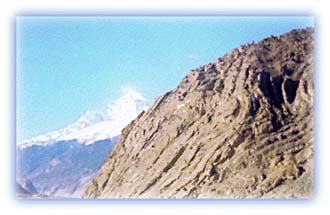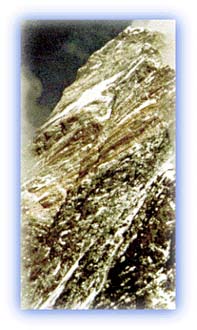Geology
· Formation of Himalayas
·Scientific Methods

![]()
| Visual Evidences of Himalayan Formation The Indian plate is continuously moving north at the rate of about 2 cms every year. Because of this reason the Himalayas are rising at the rate of about 5 millimeter per year. Even so, it is impossible to detect the movement of the plates and uplifting of the Himalayas by casual observation. But, even though we cannot visually observe the plates moving and the mountains rising, we can draw some of our own conclusions from observing rock formations and fossils from the past. |
 |
| Tilted sedimentary rock near Kagbeni, Nepal. Credit: Mahabir Pun |
The picture on the left shows clear folding in the Himalayan rocks. The rocks start folding from near the valley floor and tilt towards the higher snow covered peaks. These rocks are also sedimentary rocks, which suggests that they were on the sea bed long ago.
 |
| Layers of sedimentary rocks in the high Himalayas. Credit: Mahabir Pun |
The picture in the right shows horizontal layers in the rocks. These layers are typical of sedimentary rocks as the soil gets deposited over a period of time, and hardens layer by layer to form the rock.
 |
| Highly folded rocks near Dhaulagiri. Credit: Mahabir Pun |
The picture displays highly folded and uplifted sedimentary rocks. The river flowingin the region is the Kali Gandaki and in the distance is the seventh highest peak of the world, Dhaulagiri I 26,795 ft (8,167 m) high. Geologists say that the river bed of the Kali Gandaki is older than the Himalayas.
 |
| Fossils scattered on a high mountain field. Credit: Mahabir Pun |
Fossils of a marine animal called Ammonite are found in large numbers in the Kali Gandaki river in Nepal. Ammonites were sea animals having shells - either straight or coiled. When the Tethys sea disappeared, they were caught in the shale layers of clay and transformed into fossils. Some of the fossils are large with a diameter up to 2 m.
 |
| A large fossil in the backyard of a house with a girl standing on it. Credit: Mahabir Pun |
There are many big ammonite fossils in the Muktinath area of the Kali Gandaki valley, Nepal at around the elevation of 12,000 ft above sea level. This is one of the proofs that the Himalayas were indeed once under water. For many people who have faith in the Hindu religion, ammonite is one of the many forms of their Lord Vishnu. They keep the fossil in their worship room and worship it.
 |
| Top of Mt. Everest showing Sedimentary Layers. Credit: Mahabir Pun |
This picture shows layers of sedimentary rock near the top of Mt. Everest which were formed millions of year ago under the Tethys sea. Such sedimentary layers have been found at the top of many Himalayan peaks. The sedimentary rock layers offer evidence of the tectonic force that lifted the Himalayas more than 8,000 m (26,000 ft) up from the sea floor.
All rights reserved